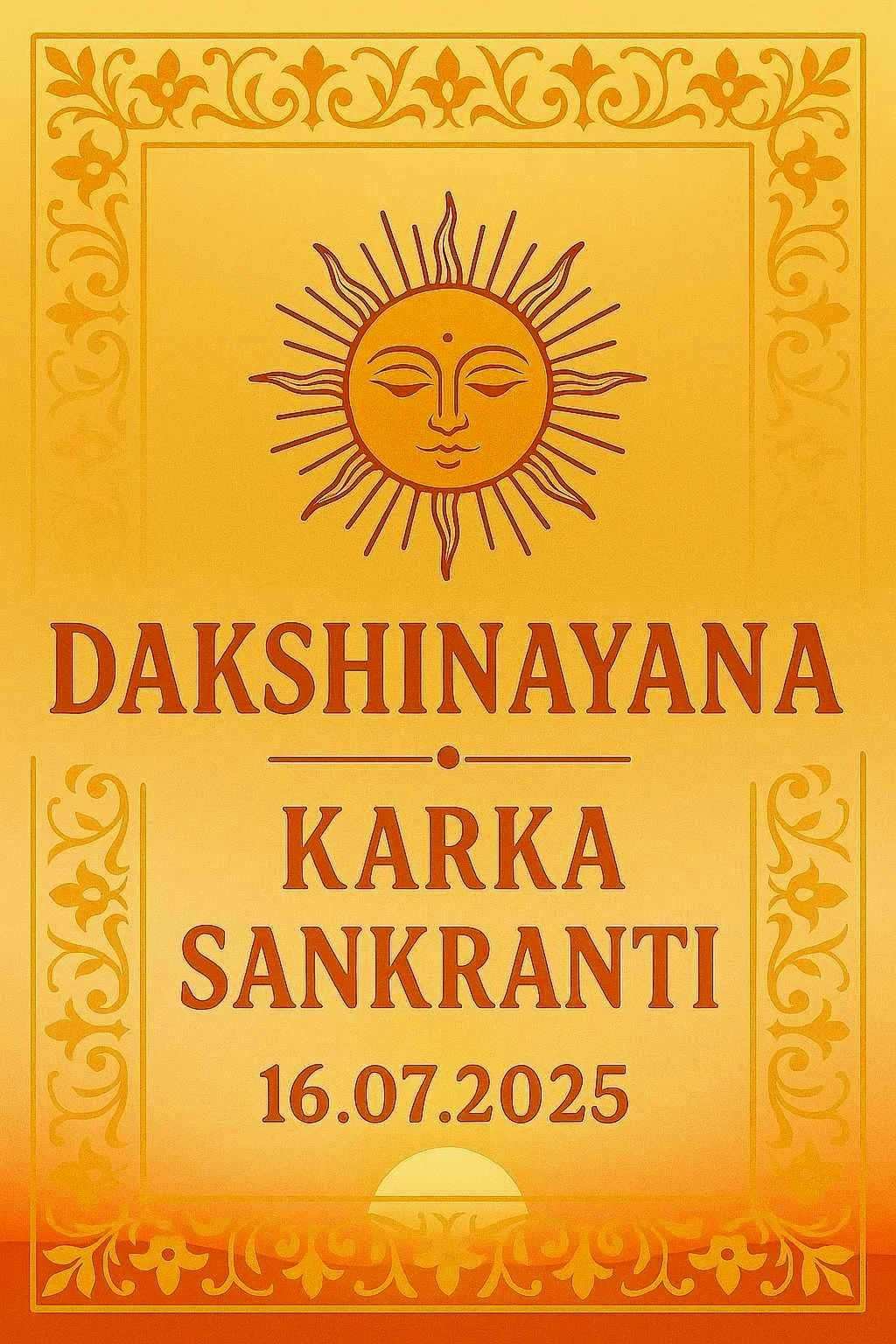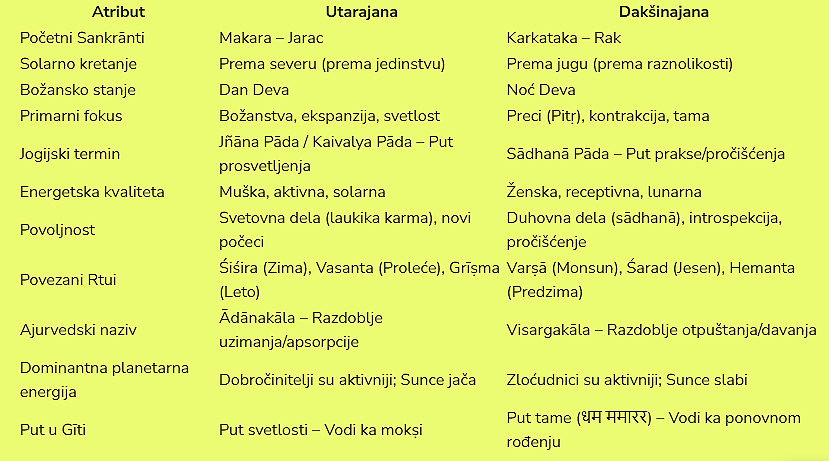Dakṣiṇāyana – July 16, 2025
Sun (Surya) enters the constellation of Cancer (Karka) on July 16, 2025
Dakṣiṇāyana is a Sanskrit compound formed from the words dakṣiṇa (दक्षिण) – "south" and ayana (अयन) – "path, movement, journey." Literally, the term means “southern path” of the Sun. Behind this seemingly simple expression lies one of the fundamental cycles that determine the flow of time, the meaning of natural rhythms, and the inner architecture of ancient cosmological systems.
In both astrological and astronomical terms, Dakṣiṇāyana refers to the six-month period during which the Sun, from the perspective of an observer in the northern hemisphere, appears to move southward along the celestial sphere. This “journey to the south” begins at the moment when the Sun reaches its northernmost point and continues until January 14, 2026, when it touches its southernmost limit.
This cycle, which for the Vedic mind was not merely an astronomical fact but a symbol of a deeper cosmic order, ushers in a time of slowing down, withdrawal, and inner consolidation. In comparison to Uttarāyaṇa, Dakṣiṇāyana is the half of the year that belongs to the quiet forces of inner life, to the forces of ancestors and invisible stewards of destiny—when days grow shorter, nights become longer, and the Sun hands over its light to another order, ever-present behind the appearance of daylight.
Thus, Dakṣiṇāyana becomes more than just an astronomical phase: it marks the beginning of the inner year for every being capable of hearing the silence in which the seed of a new cycle is growing.
Karkataka Sankranti
In Vedic astrology, the division between the cycles of light and darkness, expansion and withdrawal, is determined with particular precision. According to the Nirayana (sidereal) zodiac, which is the foundation of all classical Indian astronomical and astrological systems, Dakṣiṇāyana begins precisely at the moment of Karkataka Sankranti (also called Karka Sankramanam)—the exact instant when the Sun enters the rāśi (sign) of Karkataka (Cancer). This moment usually occurs around July 16th in the Gregorian calendar.
This stands in clear contrast to the Sayana (tropical) system, where the southern movement of the Sun begins at the summer solstice, around June 21st. Within that contrast between the two systems lies a deep awareness of the precession of the equinoxes—the silent shifting of celestial points that carries with it the perpetual tension between astronomical time and the truth of cosmic order.
Classical texts like the Bṛhat Saṃhitā are not silent on this matter. They warn, with admonitory seriousness, about the potentially disastrous consequences of shifting the ayana before the Sun has truly entered the corresponding rāśi. For Indian thought, a miscalculation of this celestial threshold is not just an astronomical error—it is a violation of the cosmic order that connects humans, gods, and ancestors.
From Cancer Entry to Capricorn Exit: The Inner Logic of the Cycle
The Dakṣiṇāyana period lasts six solar months—during which the Sun traverses the six rāśis of Karkataka (Cancer), Simha (Leo), Kanya (Virgo), Tula (Libra), Vṛścika (Scorpio), and Dhanuṣa (Sagittarius). This cycle culminates and ends with Makara Sankranti, when the Sun enters Makara (Capricorn) and thereby begins a new half-year period—Uttarāyaṇa, the Sun’s northward journey.
It is important here to clearly distinguish between the tropical solstice (June 21), which modern astronomy considers the beginning of the Sun’s southern motion, and the sidereal Karkataka Sankranti (around July 16), which Vedic astrology (Jyotiṣa) recognizes as the true start of Dakṣiṇāyana.
While contemporary science ties the seasons to solstices and equinoxes—i.e., to the Earth’s axial tilt—Vedic astrology remains oriented toward the Sun’s entrance into specific rāśis. In this case, into Karkataka—a water sign, feminine, and ruled by the Moon.
The significance of this moment is not merely a technical change in declination, but the Sun’s entry into a specific energetic field, whose qualities define the nature of the entire period. Only with the Sun’s entrance into Karkataka do the true astrological effects of Dakṣiṇāyana commence—hence the warnings from texts like the Bṛhat Saṃhitā that any premature shifting of the ayana before the actual sankranti can have negative consequences.
Thus, the ṛṣis affirm that predictable worldly influences do not depend on physical astronomy, but on alignment with the rāśi. The true onset of the astrological influence of Dakṣiṇāyana occurs only when the Ātmakāraka (significator of the soul, the Sun) enters the domain of the Manokāraka (significator of the mind, the Moon). At that moment begins a period in which the universal soul withdraws from the outer, public realm into the inner, receptive, and emotional world. This transition defines the theme of this half-year: introversion, purification, and restoration of inner order.
The Sacred Dimension of the Southern Solar Path
In the Purāṇic and metaphysical thought of Indian tradition, time is not merely a sequence of days and nights, but a reflection of a higher order, of the rhythm of gods and ancestors. One of the fundamental concepts in the Purāṇas is that a human year constitutes one day and one night for the Devas (divine beings).
Within this structure, Uttarāyaṇa is the day of the gods, the time of their wakefulness and activity, while Dakṣiṇāyana is their night—a period of withdrawal and silence. During this celestial night, it is believed that the deities enter yoga-nidrā—a yogic sleep whose deepest embodiment is the slumber of Lord Viṣṇu, which begins on Devashayani Ekādaśī.
As the time of the Devas wanes, space opens for the time of the Pitṛs (ancestors). Dakṣiṇāyana is thus also known as Pitṛyāṇa—the path of the ancestors. During this period, the ancestors are said to draw closer to the earthly plane, making rites such as Śrāddha and Tarpana especially powerful and effective. This is clearly codified in the Bhagavad Gītā (8.25), where the "path of darkness" (smoke, night, waning moon, six months of Dakṣiṇāyana) is interpreted as the route leading to rebirth, in contrast to the "path of light" (Uttarāyaṇa), which leads to liberation from the cycle of saṃsāra.
The southern direction, in the symbolism of the Vedic world, belongs to Yama, the lord of Dharma and death. Therefore, Dakṣiṇāyana is often called Yama’s path—a route leading into the material, mortal, and karmic dimensions of existence. In this sense, Dakṣiṇāyana becomes far more than an astronomical interval: it is a metaphysical threshold, a time of the withdrawal of light and the opening to inner, unseen forces that shape the destiny of individuals and the world.
Fundamental Astrological Principles in Jyotiṣa Śāstra
General Inauspiciousness (aśubhatvam)
In the Jyotiṣa tradition, a foundational principle is that Dakṣiṇāyana is generally considered less auspicious (aśubha) for worldly, creative, and expansive activities (laukika karma)—such as marriages, housewarming ceremonies (gṛhapraveśa), coronations, or the launching of new ventures. This is interpreted as a direct result of Dakṣiṇāyana’s status as the “night of the gods”—a period in which divine support for new beginnings is weakened or withdrawn. Accordingly, restraint in initiating important worldly deeds during this time is advised.
Connection with Ṛtus (Seasons)
The six months of Dakṣiṇāyana, from both an astrological and Ayurvedic perspective, are linked to three ṛtus (seasons): Varṣā (monsoon), Śarad (autumn), and Hemanta (late autumn/early winter). These seasonal transitions bring increased moisture, lower temperatures, and heightened influence of the Moon (Soma)—which has far-reaching implications for both health and worldly astrology.
In Ayurvedic theory, this period is known as Visarga Kāla—a time when the cooling and nourishing energies of the Earth become more pronounced, naturally strengthening bodily vitality and resilience. In both systems, Dakṣiṇāyana is defined as a time of inner consolidation and recovery, when outward expansion gives way to withdrawal, nourishment, and preparation for the next cycle.
Summary Table: Dualistic Framework of Ayanas
The following table presents dozens of dispersed concepts in a clear and dualistic structure, enabling the reader to immediately grasp the fundamental polarity between the two ayanas—Uttarāyaṇa and Dakṣiṇāyana. This polarity is not merely a division of the solar year into two halves; it reveals two essentially different cosmic paradigms that permeate all aspects of the Vedic time cycle.
Uttarāyaṇa and Dakṣiṇāyana are not just calendar terms: each ayana signifies a complete mode of existence, with its own rhythms, metaphysical laws, and consequences for worldly, spiritual, and natural flows. The dualistic structure offers a clear understanding of the organizational basis of the Vedic year and makes visible the dynamic interplay between light and darkness, expansion and contraction, the day of the gods and their night.
| Attribute | Uttarāyaṇa | Dakṣiṇāyana |
|---|---|---|
| Initial Sankrānti | Makara (Capricorn) | Karkataka (Cancer) |
| Solar Movement | Northward (toward unity) | Southward (toward diversity) |
| Divine Condition | Day of the Devas | Night of the Devas |
| Primary Focus | Gods, expansion, light | Ancestors (Pitṛ), contraction, darkness |
| Yogic Term | Jñāna Pāda / Kaivalya Pāda – Path of enlightenment | Sādhanā Pāda – Path of practice/purification |
| Energy Quality | Masculine, active, solar | Feminine, receptive, lunar |
| Activities | Worldly deeds (laukika karma), new beginnings | Spiritual practice (sādhanā), introspection, purification |
| Related Ṛtus | Śiśira (Winter), Vasanta (Spring), Grīṣma (Summer) | Varṣā (Monsoon), Śarad (Autumn), Hemanta (Pre-winter) |
| Ayurvedic Term | Ādānakāla – Time of absorption/taking | Visargakāla – Time of release/giving |
| Dominant Planetary Energy | Benefics are stronger; the Sun gains strength | Malefics are more active; the Sun weakens |
| Path in the Gītā | Path of light – Leads to mokṣa (liberation) | Path of darkness (धूम मार्ग) – Leads to rebirth |
This text is an excerpt from the book “Essays on Astrology”.
Dakšinajana – 16. jul 2025
Sunce (Surja) ulazi u sazvežđe Raka (Karka) 16. Jula, 2025
Dakṣiṇāyana je sanskritska složenica nastala od reči dakṣiṇa (दकक्षिण) – „jug“ i ayana (अयन) – „put, kretanje, putovanje“. Doslovno, ovaj pojam znači „južni put“ Sunca.
Iza te naizgled proste konstrukcije, stoji jedan od temeljnih ciklusa koji određuju tok vremena, smisao ritmova prirode i unutrašnju arhitekturu drevnih kosmoloških sistema.
U astrološkom i astronomskom smislu, Dakšinajana označava šestomesečno razdoblje u kojem Sunce, iz ugla posmatrača na severnoj hemisferi, prividno silazi prema jugu na nebeskoj sferi.
Taj „put prema jugu“ započinje u trenutku kada Sunce doseže najseverniju tačku svoga hoda, i traje sve do 14.01.2026, kada će Sunce dotaći svoju najjužniju granicu.
Ovaj ciklus, koji je za vedski um bio ne samo astronomska činjenica već i simbol dubljeg reda sveta, uvodi nas u vreme usporavanja, povlačenja i sabiranja.
Dakšinajana je, u poređenju s Utarajanom, polovina godine koja pripada tihim silama unutrašnjeg života, silama predaka i nevidljivih rukovoditelja sudbine, gde dani postaju kraći, a noći duže, dok Sunce svoju svetlost predaje drugom poretku, uvek prisutnom iza privida dnevnog svetla.
Na taj način, Dakšinajana postaje više od puke astronomske etape: početak unutrašnje godine svakog bića koje ume da čuje tišinu u kojoj raste seme novog ciklusa.
Karkataka Sankranti
U vedskoj astrologiji, razgraničenje ciklusa svetlosti i tame, širenja i povlačenja, određuje se s naročitom preciznošću.
Prema Nirajana (siderealnom) zodijaku, koji je osnova svih klasičnih indijskih astronomskih i astroloških sistema, Dakšinajana počinje tačno u trenutku Karkataka Sankranti (ili Karka Sankramanam) – onog časa kada Sunce prelazi u raši (znak) Karkataka (Rak).
Taj trenutak najčešće se događa oko 16. jula po gregorijanskom kalendaru.
Time se jasno izdvaja razlika u odnosu na Sajana (tropski) sistem, gde južno kretanje Sunca započinje letnjim solsticijem, oko 21. juna.
U tom kontrastu između dva sistema, otkriva se duboka svest o precesiji ekvinocija – o tihom pomeranju nebeskih tačaka, koje sa sobom nosi večitu napetost između astronomskog vremena i istine o poretku sveta.
Klasični tekstovi, poput Brhatsamhite, nisu ostali nemi pred tim pitanjem.
U njima se, s opominjućom ozbiljnošću, upozorava na moguće pogubne posledice ako se ayana pomeri pre nego što Sunce zaista uđe u odgovarajući raši.
Za indijsku misao, pogrešno određivanje ovog nebeskog praga nije samo astronomska greška, već povreda reda koji povezuje ljude, bogove i pretke.
Od ulaska u Karkataku do izlaska u Makaru: unutrašnja logika ciklusa
Razdoblje Dakšinajane traje šest solarnih meseci – tokom kojih Sunce prolazi kroz šest rašija: Karkataka (Rak), Simha (Lav), Kanya (Devica), Tula (Vaga), Vršcika (Škorpion) i Dhanus (Strelac).
Ovaj ciklus doseže svoj vrhunac i završava sa Makara Sankranti, kada Sunce ulazi u Makaru (Jarac) i time otpočinje novo polugodište – Utarajana, severni hod Sunca.
Ovde valja jasno uočiti razliku između tropskog solsticija (21. juna), kojim moderna astronomija određuje početak južnog kretanja Sunca, i sideralnog Karkataka sankrantija (oko 16. jula), koji vedska astrologija (Jyotiṣa) priznaje kao pravi početak Dakšinajane.
Dok nauka savremenog doba godišnja doba vezuje za solsticije i ekvinocije – dakle za relaciju Sunca prema nagibu Zemlje – vedska astrologija ostaje usmerena na ulazak Sunca u određeni raši, u ovom slučaju u Karkataku – vodeni, ženski znak, pod vlašću Meseca.
Značaj ovog trenutka nije samo tehnička promena deklinacije, već ulazak Sunca u specifično energetsko polje, čije osobine određuju i kvalitet samog perioda.
Tek sa ulaskom u Karkataku, pokreću se istinski astrološki učinci Dakšinajane, otuda i upozorenje iz Brhatsamhite, jednog od klasičnih tekstova, da svako pomeranje ajane pre stvarnog sankrantija može imati negativne posledice.
Time rišiji potvrđuju da predvidivi svetovni uticaji ne zavise od fizičke astronomije, već od usklađenosti sa rašijem.
Pravi početak astrološkog dejstva Dakšinajane nastaje tek kada Atmakaraka (signifikator duše, Sunce) uđe u domen Manokarake (signifikatora uma, Meseca).
Tada započinje period u kojem se univerzalna duša povlači iz spoljašnjeg, javnog, ka unutrašnjem, prijemčivom i emotivnom svetu.
Taj prelazak određuje i temu ovog polugodišta: introvertiranost, pročišćenje i obnovu unutrašnjeg reda.
Sakralna dimenzija južnog solarnog puta
U puranskom i metafizičkom mišljenju indijske tradicije, vreme nije puki sled dana i noći, već odraz višeg poretka, ritma bogova i predaka.
Jedan od temeljnih pojmova u Puranama jeste da ljudska godina predstavlja jedan dan i jednu noć za Deve (božanske sile).
U tom rasporedu, Utarajana je dan bogova, vreme njihove budnosti i delanja, dok je Dakšinajana njihova noć, period povlačenja i tišine.
Tokom ove nebeske noći, veruje se da su božanstva u joga nidri – jogijskom snu, čije najdublje oličenje nalazi u snu Gospodina Višnua, započetom na Devasayani ekadaši.
Kako vreme Deva jenjava, otvara se prostor za vreme Pitra – predaka.
Dakšinajana je, stoga, poznata i kao Pitrijana – put predaka.
U ovom periodu, preci se prema tradiciji spuštaju bliže zemaljskoj sferi, čineći obrede poput Šrade i Tarpane naročito moćnima i delotvornima.
To je jasno kodifikovano u Bhagavad Giti (8.25), gde se „put tame” (dim, noć, opadajući mesec, šest meseci Dakšinajane) tumači kao staza koja vodi ponovnom rođenju, za razliku od „puta svetlosti” (Utarajana) koji vodi oslobođenju iz ciklusa samsare.
Južni pravac, prema simbolici vedskog sveta, pripada Jami, gospodaru Dharme i smrti.
Stoga se Dakšinajana često naziva i Jaminim putem – putem koji vodi u materijalne, smrtne i karmičke dimenzije postojanja.
U tom smislu, Dakšinajana postaje mnogo više od običnog astronomskog intervala: ona je metafizički prag, vreme povlačenja svetlosti i otvaranja prema unutrašnjim, nevidljivim silama koje određuju sudbinu ljudi i čitavog sveta.
Fundamentalna astrološka načela u Jyotiṣa Śāstrama
Opšta nepovoljnost (aśubhatvam)
U đotiš tradiciji, jedna od osnovnih postavki jeste da se Dakšinajana uopšteno smatra manje povoljnom (aśubha) za svetovne, stvaralačke i ekspanzivne aktivnosti (laukika karma) – venčanja, useljenja (gṛhapraveśa), krunidbe i započinjanje novih poduhvata.
Ovo se tumači kao direktna posledica statusa Dakšinajane kao „noći bogova“ – perioda u kojem je božanska podrška za nove početke oslabljena ili povučena.
U skladu s tim, preporučuje se suzdržanost u pokretanju važnih svetovnih dela tokom ovog perioda.
Povezanost s Ṛtuima (godišnjim dobima)
Šest meseci Dakšinajane, kako iz ugla astrologije, tako i ajurvede, povezano je s tri godišnja doba (ṛtu): Varsa (monsun), Šarad (jesen) i Hemanta (kasna jesen/predzima).
Ove sezonske promene donose povećanu vlagu, snižene temperature i jačanje uticaja Meseca (Soma), što ima dalekosežne implikacije na zdravlje i svetovnu astrologiju.
U ajurvedskoj teoriji, ovaj period se naziva Visargakala – vreme kada rashlađujuće i hranjive energije zemlje dolaze do izražaja, prirodno jačajući snagu i vitalnost tela.
U oba slučaja, Dakšinajana je definisana kao vreme unutrašnje konsolidacije i oporavka, u kojem spoljašnja ekspanzija ustupa mesto povlačenju, negovanju i pripremi za naredni ciklus.
Tabela: Dualistički okvir ajana
Donja tabela prikazuje desetine rasutih podataka u jasan i dualistički okvir, omogućavajući čitaocu da neposredno uvidi temeljnu polarnost između dve ajane – Utarajana i Dakšinajana. Ova polarnost ne predstavlja samo puku podelu na dve polovine solarne godine, već razotkriva dve suštinski različite kosmičke paradigme, koje prožimaju sve aspekte vedskog ciklusa vremena. Utarajana i Dakšinajana ovde nisu tek kalendarske kategorije: svaka ajana označava celoviti način postojanja, sa sopstvenim ritmovima, metafizičkim zakonitostima i posledicama po svetovne, duhovne i prirodne tokove. Dualistički okvir omogućava jasno razumevanje ove organizacione osnove vedske godine i čini vidljivom dinamiku između svetlosti i tame, ekspanzije i povlačenja, dana bogova i njihove noći
Tekst preuzet iz knjige „Eseji o astrologiji“.




